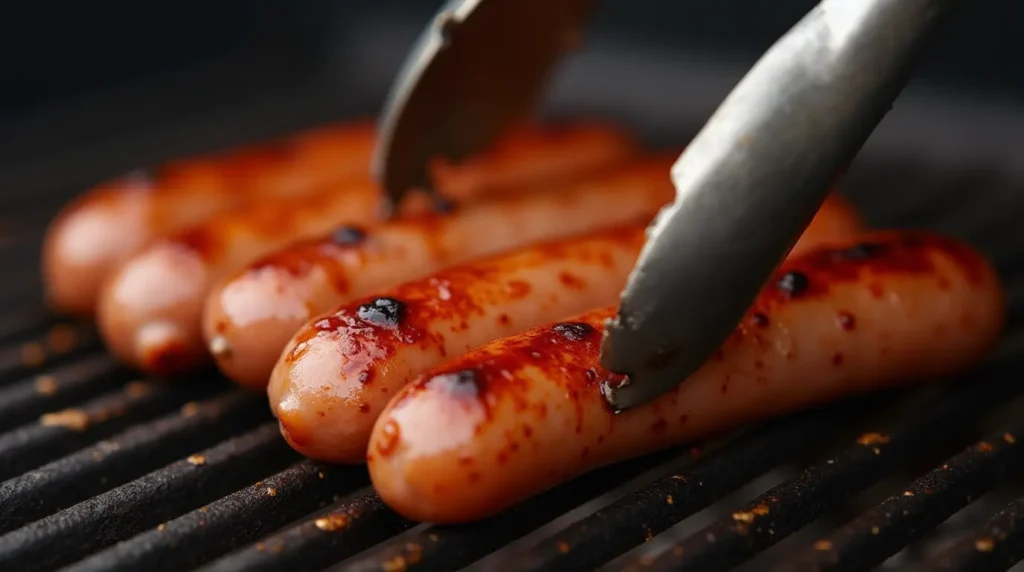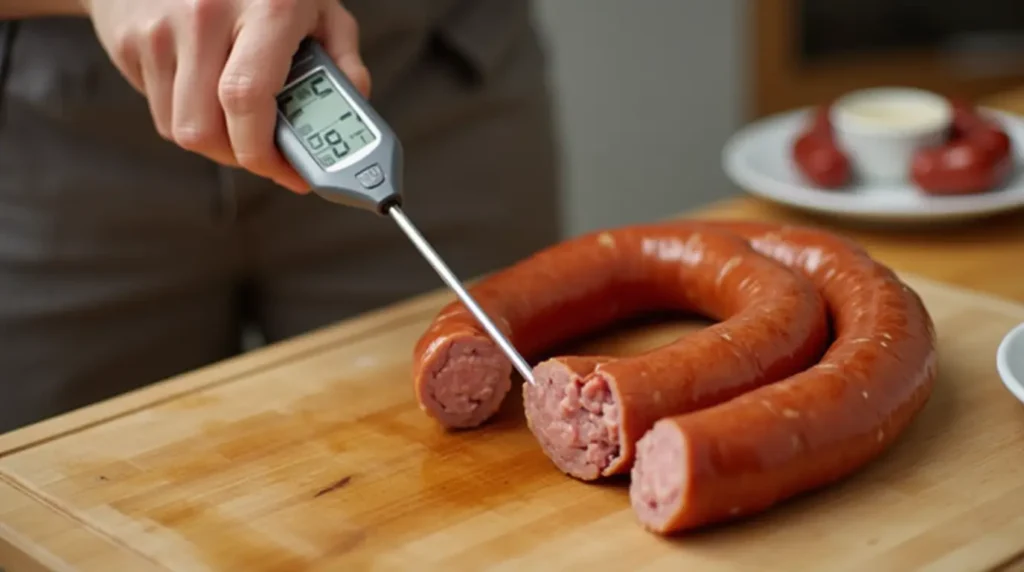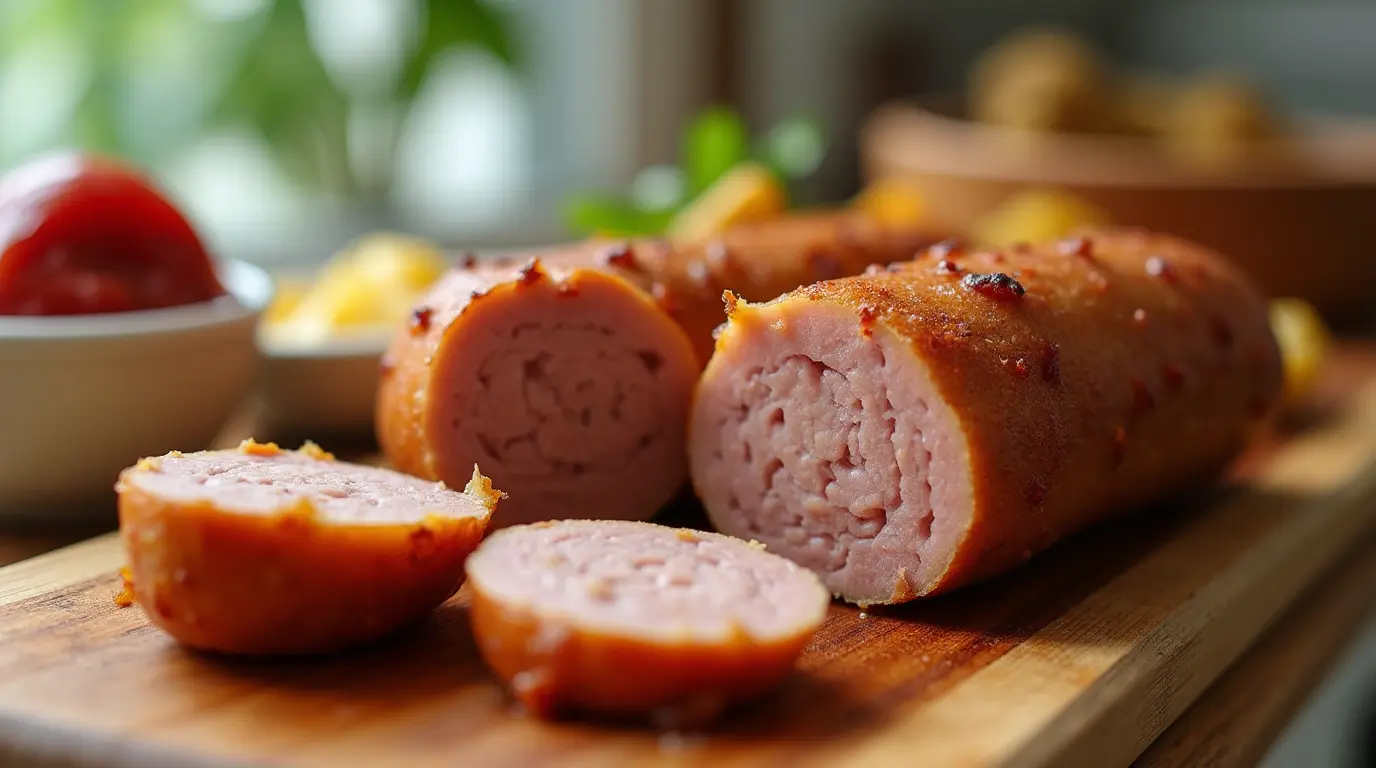Understanding Sausage Basics
Sausages come in various forms, and each type demands specific sausage doneness tips for a safe, tasty result. If you’re ever unsure about how to tell if a sausage is cooked, start by identifying whether it’s raw, pre-cooked, or cured. For a deeper understanding of packaged sausages and their preparation, visit Are Packaged Sausages Already Cooked?. This distinction shapes how much heat and time you need to ensure sausage is fully cooked. Remember that thorough cooking not only delivers superior flavor but also protects you from foodborne risks. Staying mindful of key cooked sausage indicators (like color, texture, and juice clarity) reduces the chance of serving something underdone.
Types of Sausages (Raw, Pre-Cooked, Cured)
- Raw Sausages: These rely on fresh ground meat. You must handle them carefully to prevent bacterial growth. During cooking, keep an eye on checking sausage doneness by slicing one open or using a meat thermometer to confirm a safe internal temperature.
- Pre-Cooked Sausages: Smoked or partially cooked products (like hot dogs) might only need reheating. Still, apply sausage safety checks to verify if they’ve reached a suitable internal temperature.
- Cured Sausages: Items such as salami or pepperoni undergo a curing process. Some can be eaten without further cooking, yet others benefit from light heating for taste. If the package instructions say “ready to eat,” you can focus mostly on flavor, but if it’s labeled “cook before eating,” apply normal cooked sausage indicators and temperature checks.
Common Cooking Methods (Grilling, Frying, Boiling, etc.)
Sausages adapt to different heat sources. Grilling offers smoky notes and can highlight color changes, a key sign for sausage safety checks. Frying produces a crisp, browned surface—one of the simpler cooked sausage indicators that helps you gauge doneness. Boiling keeps meat moist, though it sometimes washes away strong flavors, making it best to follow up with a quick sear.
Baking is hands-off and frees you for other tasks, but you should still test internal temperature to ensure sausage is fully cooked. By matching the method to the sausage style, you’ll know how to tell if a sausage is cooked? without risking raw spots or overdone edges.
Why Proper Cooking is Essential
Sausages bring big taste to any meal, yet proper cooking does more than boost flavor—it safeguards health. When you skip checking sausage doneness, you increase the risk of undercooking, which can lead to bacterial contamination. Meanwhile, overcooking may dry out the meat and ruin its texture. Finding the sweet spot requires solid sausage doneness tips that emphasize both safety and taste. You can then enjoy a savory bite without worrying about harmful
Risks of Undercooked Sausages (Foodborne Illnesses)
Raw or partially cooked meat can harbor bacteria like Salmonella or E. coli. If you fail to ensure sausage is fully cooked, these microbes might remain alive, causing potential foodborne illnesses. Symptoms include stomach pain, diarrhea, and more severe complications.
Paying attention to cooked sausage indicators—like firm texture and clear juices—reduces the odds of serving unsafe food. Using a reliable meat thermometer further cements your sausage safety checks, ensuring the core temperature hits a safe zone (usually 160–165°F / 71–74°C, depending on the meat type). This approach answers how to tell if a sausage is cooked? in a precise, science-backed way.
Enhancing Flavors and Textures
Cooking sausages to perfection unlocks flavors embedded in the meat and seasonings. Gentle heat releases aromatic oils, while browning transforms natural sugars on the surface. When done well, your final product tastes rich and succulent, thanks to the Maillard reaction that deepens color and flavor. Keeping a balance between thorough cooking and retaining moisture is key.
That’s why checking sausage doneness at intervals is helpful—stop too early and the meat stays raw, but go too long and it dries out. Aim for moderate heat and use a combination of sausage doneness tips (like color checks, firmness tests, and juice clarity) to land on that perfect texture. By doing so, you create a safer, more flavorful meal while confidently fulfilling all the necessary sausage safety checks.
Visual Indicators of Cooked Sausages
Color Changes (Outside and Inside)
Color is one of the first cooked sausage indicators you notice. When you wonder How to Tell if a Sausage is Cooked?, look at both the outside and inside. An undercooked sausage often appears pale or slightly gray on the surface, with a pink or translucent center. As you apply heat, it shifts to a more opaque shade, and the interior loses its raw, rosy tint. This transformation is key to checking sausage doneness because it tells you that proteins have begun to firm up. Although color alone should not be your only method, it’s an excellent visual cue to ensure sausage is fully cooked. Pair this observation with other sausage safety checks, like measuring internal temperature or doing a small cut test, for complete confidence.

Texture Firmness
Firmness offers another straightforward way to gauge sausage doneness tips. If you press gently on a raw or undercooked sausage, it will feel squishy or soft. A fully cooked link, by contrast, should spring back slightly under pressure. This happens because the proteins and fats tighten as they heat, giving the sausage a pleasant bite. When you perform checking sausage doneness by feeling its texture, you reduce the risk of biting into raw meat. However, rely on more than just feel if you want to ensure sausage is fully cooked. Pair a firmness check with color or a meat thermometer reading. By combining these methods, you streamline your sausage safety checks and serve a safer, more enjoyable meal.
External Browning and Caramelization
A golden-brown exterior often signals that you’re on the right track for How to Tell if a Sausage is Cooked?. Browning and caramelization occur when heat interacts with the natural sugars in the meat, creating a richer taste. This crisp or slightly charred surface not only indicates cooked sausage indicators but also enhances the final flavor and texture. Still, browning alone does not always mean the sausage’s interior has reached a safe temperature. Large or thick sausages might appear perfectly seared yet remain pink inside. Thus, remember to follow your usual sausage doneness tips, like checking the color within or using a thermometer. These small steps ensure sausage is fully cooked from edge to edge, helping you enjoy a delicious, risk-free bite.
Using a Meat Thermometer
A meat thermometer offers one of the most reliable ways for checking sausage doneness. Different sausages have different safe internal temperatures. Pork links typically need to reach about 160°F (71°C) to ensure sausage is fully cooked, while poultry varieties, such as chicken or turkey sausages, often require 165°F (74°C). These numbers matter because harmful bacteria die off at those heat levels, making it safe to enjoy every bite. Relying on a thermometer helps you see beyond surface color—dark browning alone doesn’t guarantee a safe interior. By following proper guidelines, you’ll stay on top of all necessary sausage safety checks.

Correct Internal Temperature for Different Types of Sausages
- Pork Sausages: Aim for 160°F (71°C)
- Beef Sausages: Aim for 160°F (71°C)
- Chicken/Turkey Sausages: Aim for 165°F (74°C)
Step-by-Step Guide to Using a Thermometer
- Insert the Probe: Gently push the thermometer into the thickest part of the sausage, avoiding direct contact with the pan or grill.
- Wait for a Steady Reading: Give the display a few seconds to stabilize. If it remains below the recommended level, keep cooking until you reach the right range.
- Check Multiple Links: Large batches might cook unevenly, so repeat the process on a few links. This ensures every piece meets cooked sausage indicators.
- Confirm Safe Doneness: If the thermometer reads 160–165°F, you’ve found how to tell if a sausage is cooked? In other words, you can trust it’s no longer raw and has reached a safe zone.
Using a thermometer is among the best sausage doneness tips. It removes guesswork and helps you serve juicy sausages that meet all sausage safety checks for both flavor and peace of mind
The Cut Test Method
The cut test offers a straightforward, low-tech option for checking sausage doneness. It works well when you do not have a thermometer or want to confirm what’s happening inside the meat. While color on the outside can hint at cooked sausage indicators, the center reveals the final truth. Gently slicing into a sausage helps you ensure sausage is fully cooked by allowing you to inspect the interior’s color and texture. This method pairs well with other sausage safety checks, like feeling for firmness or checking juice clarity, to give you confidence about your meal.
How to Check the Interior Visually
Start by using a clean knife or fork. Make a small cut in the thickest part of the sausage. Look for an opaque, non-pink interior. You might also spot clear juices, which often imply doneness. If you see raw or glossy areas, keep cooking until they turn more opaque. Adopting this tip, along with other sausage doneness tips, helps answer How to Tell if a Sausage is Cooked? without relying on guesswork.
Common Signs of Undercooked Sausage (Pink Meat, Raw Texture)
Undercooked sausages often appear pink or show a translucent, raw-looking texture in the center. If you notice these signs during the cut test, return the sausage to the heat. Additionally, pay attention to mushy, loose textures, which indicate incomplete cooking. Proper heating will make the meat firm and remove any traces of rawness. Remaining vigilant about these cooked sausage indicators ensures that you eliminate harmful bacteria. By making a quick, simple cut and acting on what you see, you reduce the risk of serving unsafe food and make sure your sausages meet essential sausage safety checks.

Juices as an Indicator
Observing the juices that seep out of a sausage can be a quick solution for checking sausage doneness—especially when you are unsure how to tell if a sausage is cooked?. By piercing the sausage with a fork or small knife, you can watch the liquid that escapes. If those juices look clear or light brown, you likely have cooked sausage indicators. On the other hand, pink or red-tinged fluids may signal that the meat needs more heat to ensure sausage is fully cooked. While this method is not foolproof on its own, it remains a valuable tool in your lineup of sausage doneness tips.
Clear vs. Pink Juices When Pierced
Clear juices often mean you have heated the sausage to a point where any harmful bacteria have been neutralized, supporting essential sausage safety checks. Pink or red juices, however, suggest you are dealing with a partially cooked interior. In these cases, return the sausage to your pan or grill and continue cooking until the liquid shifts to a clearer shade.
Why This Method Works Well for Fresh Sausages
Fresh sausages begin as raw ground meat, so the color of their juices offers a direct glimpse into the cooking process. Once these sausages lose any pink or red liquid, you can feel more confident that you have reached a safe internal temperature. Because fresh sausages lack the curing agents found in many pre-cooked or smoked varieties, their juice color becomes an effective pointer to checking sausage doneness. Pair this juice check with other sausage doneness tips—like firmness or internal temperature readings—so you can ensure sausage is fully cooked with minimal guesswork.
FAQs About Cooking Sausage
Is it safe to eat slightly pink sausage?
Only if it reaches the correct internal temperature (around 160–165°F), because curing agents can keep it pink even when fully cooked.
How can you tell if frozen sausages are fully cooked?
Use a meat thermometer or cut to check for firm, opaque centers with clear juices.
What happens if you overcook sausage?
It becomes dry, tough, and can lose much of its flavor and juiciness.
Conclusion
Cooking sausages to perfection requires diligence and a few key steps. By checking sausage doneness using color, texture, and clear juices, you gain a solid understanding of how to tell if a sausage is cooked?. Tools like a thermometer help confirm cooked sausage indicators, ensuring you reach the right internal temperature without overcooking. Meanwhile, quick methods—such as the cut test or juice observation—offer handy spot checks for those moments when you don’t have special equipment. Each of these sausage doneness tips contributes to a safe, tasty meal.
Keep in mind that no single method stands alone. The best approach combines multiple sausage safety checks. Pair visual cues with a thermometer reading, or follow a cut test with a gentle press to confirm firmness.

